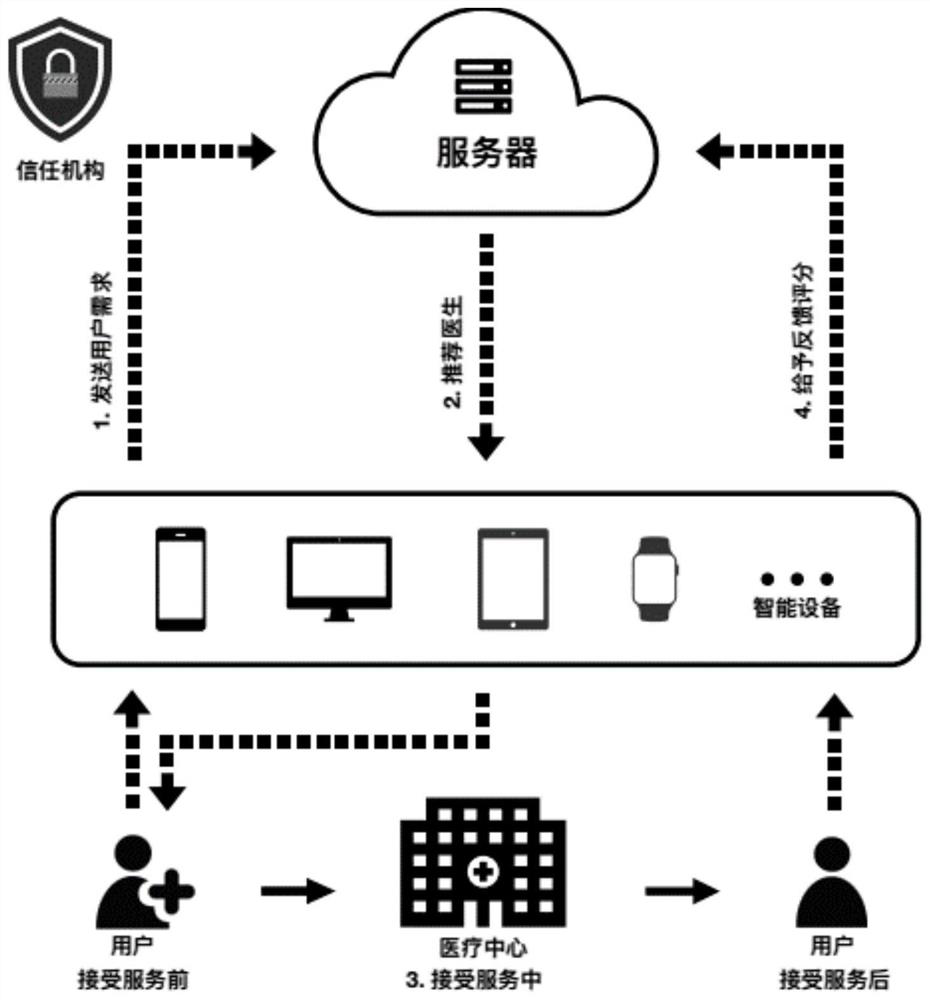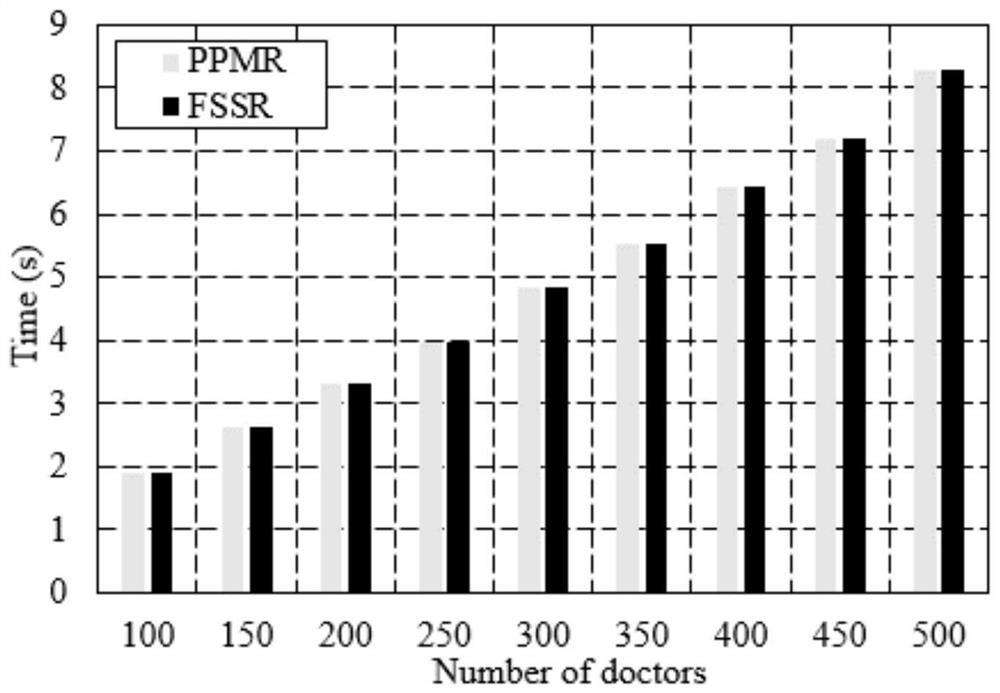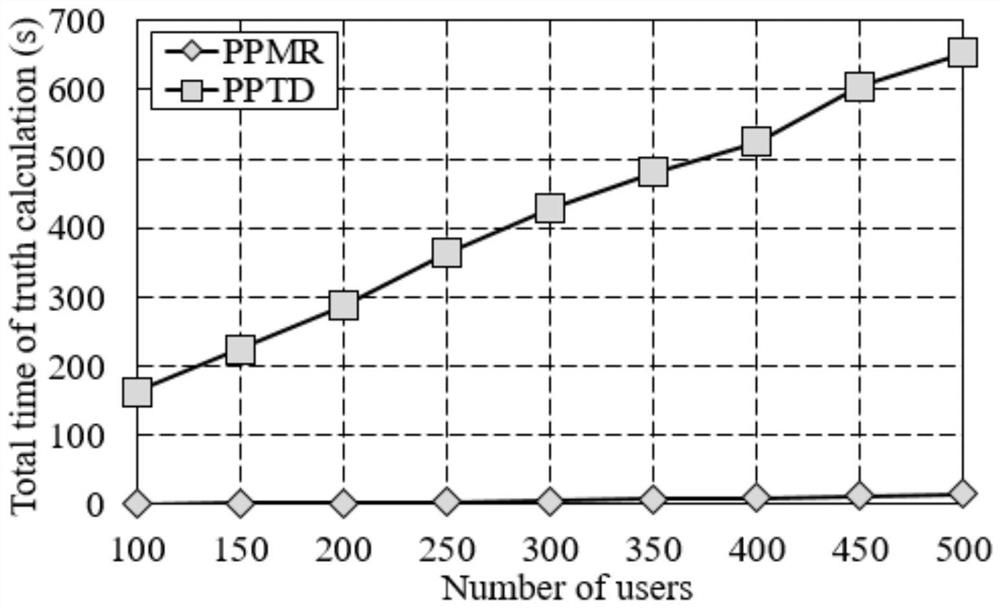A privacy-preserving medical service recommendation method in an electronic medical system
A medical service and electronic medical technology, applied in the field of privacy protection medical service recommendation, can solve the problems of consuming large computing resources, affecting accuracy, inapplicability, etc., achieving the effect of accurate and reasonable recommendation results and improving efficiency
- Summary
- Abstract
- Description
- Claims
- Application Information
AI Technical Summary
Problems solved by technology
Method used
Image
Examples
Embodiment 1
[0066] This embodiment elaborates in detail the system model diagram on which the privacy protection medical service recommendation method in the electronic medical system of the present invention relies, as shown in figure 1 shown.
[0067] From figure 1 It can be seen that when a patient user wants to apply for medical services, the user can send a medical service request to the server through smart devices such as mobile phones, tablets, and computers. Acceptable thresholds are sent to the server.
[0068] The server uses the safe similarity matching method proposed by the present invention to calculate the similarity between the user and each doctor according to the user's needs and the doctor's information, and then screens out similarity satisfaction according to the acceptable threshold provided by the user. A part of doctors with threshold conditions. Finally, for a part of doctors screened out, the server recommends the doctor with the highest reputation score to th...
Embodiment 2
[0070] Compared with traditional medical service recommendation methods such as the medical service recommendation method in the FSSR paper by Cheng Huang et al., the FSSR recommendation method only recommends doctors based on the factor of similarity. Only consider the factor of similarity to make recommendations, and users will be matched with doctors who meet their basic needs, but the quality of doctors' services is unpredictable. The recommendation method we propose recommends doctors based on the two factors of similarity and doctor reputation score. The server first screens out a batch of doctors that meet the user's needs based on similarity, and then selects the doctor with the highest reputation score among these doctors for recommendation. To the user, the higher the reputation score, the better the service quality of the doctor. In terms of algorithmic efficiency, such as figure 2 As shown, when the number of doctors is 500, the time used by the FSSR recommendati...
Embodiment 3
[0072] For the calculation of the true value of multiple user feedback data, this scheme uses the Modified Paillier encryption algorithm to process the user feedback rating data. Compared with the PPTD scheme proposed by Miao et al., which uses the ThresholdPaillier encryption algorithm to process user data, it improves Efficiency of User Feedback Data Aggregation and Calculation of Truth. Such as image 3 As shown, when the number of users is 500, the time used by the PPTD scheme to calculate the true value is 652.23s, while the time used by our PPMR scheme to calculate the true value is 14.59s. In contrast, our scheme improves the calculation of the true value s efficiency. Specifically, the privacy-preserving truth-value discovery technology is divided into two stages: weight update and truth-value update, such as Figure 4 and Figure 5 As shown, the time used by our PPMR scheme is lower than that of the PPTD scheme in the weight update phase and the truth value update ...
PUM
 Login to View More
Login to View More Abstract
Description
Claims
Application Information
 Login to View More
Login to View More - Generate Ideas
- Intellectual Property
- Life Sciences
- Materials
- Tech Scout
- Unparalleled Data Quality
- Higher Quality Content
- 60% Fewer Hallucinations
Browse by: Latest US Patents, China's latest patents, Technical Efficacy Thesaurus, Application Domain, Technology Topic, Popular Technical Reports.
© 2025 PatSnap. All rights reserved.Legal|Privacy policy|Modern Slavery Act Transparency Statement|Sitemap|About US| Contact US: help@patsnap.com



